|
|
|
|
|
|
|
|
|
|
|
|
|
|
|
|
|
|
|
|
|
|
|
|
|
|
|
|
|
|
|
|
|
 |
| |
>
INTRODUCTION
a
fascination with imagination |
| |
>
THEME PARK MAGIC
inspirational rides and attractions |
| |
>
A PHANTOM PLOT UNFOLDS
a 2003 test from Disneyland ideas |
| |
>
THE HAUNTING BEGINS
five
years of Halloween, 2004-2008 |
|
>
BACK FROM THE GRAVE
2010-2011 with new technology |
| |
>
A 2013 RESURRECTION
a mix of new and age-old effects |
| |
>
DAWN OF THE UNDEAD
2014
show, part one |
| |
>
THE ZOMBIES EMERGE
2014 show, part two |
| |
>
A CHANGING CONCEPT
2015 show, part one |
| |
>
BUILDING PNEUMATIC FIGURES
2015 show, part two |
| |
>
ROLL UP, ROLL UP!
2015
show, part three |
| |
>
INTO THE TUNNEL...
2016
show, part one |
| |
>
MAKING MONSTERS MOVE
2016
show, part two |
| |
>
TO HELL AND BACK
2016 show, part three |
| |
>
SHARPENING THE
SENSES
2017 show, part one |
| |
>
A MAGNETIC ATTRACTION
2017 show, part two |
| |
>
THE BIG EXECUTION
2017 show, part three |
|
|
|
| |
|
The experience returns
for 2013! |
|
|
|
|
|
|
|
|
|
|
|
|
|
|
|
|
|
|
|
|
|
|
|
|
|
|
|
|
|
|
|
|
| |
Following
another two-year break, the Halloween Experience returned
again, refreshed and re-imagined with new technology! For
2013's 'Trail of the Tormented', I wanted to focus on
enhancing the theming and look of the display with some new
and more elaborate props and illusions that would hopefully entertain and
spook visitors. |
|
|
|
|
|
|
|
|
|
|
|
|
|
|
|
|
|
|
|
|
|
|
|
|
|
|
|
|
|
|
|
|
| |
|
How it started...again... |
|
|
|
|
|
|
|
|
|
|
|
|
|
|
|
|
|
|
|
|
|
|
|
|
|
|
|
|
|
|
|
|
| |
|
In August 2013,
I visited Blackgang Chine with my nan and my uncle Richard.
We visited Rumpus Mansion and as we walked through it
reminded me of all the stuff I used to build for Halloween,
and the ideas that I got from this attraction. When we got
back that evening, the topic came up in the pub, and I
thought "actually, we could do it again", and that was it -
the planning started!
Rumpus Mansion and Phantom Manor at Disneyland
Paris would again be big sources of inspiration for the new
display.
Also, I read about the construction of The Haunted House
at Alton Towers, which opened in 1992, and was later
converted into a shoot-em-up zombie ride (Duel) in
2002. Renowned theme park ride designer John Wardley came up
with the original concept, in collaboration with Keith
Sparks and his team at Sparks Creative Services.
The original ride was enormous, not
dissimilar to Phantom Manor in terms of scale, and
took riders through various haunted rooms, where they
encountered ghoulish apparitions such as demons and
poltergeists, as well as skeletons and giant spiders! Some
of these effects would inspire my own creations for the 2013
display.
|
|
|
|
|
|
|
|
|
|
|
|
|
|
|
|
|
|
|
|
|
|
|
|
|
|
|
|
|
|
|
|
|
| |
|
Setting the scene... |
|
|
|
|
|
|
|
|
|
|
|
|
|
|
|
|
|
|
|
|
|
|
|
|
|
|
|
|
|
|
|
|
| |
|
This year I
decided to theme the garden as a big graveyard, with a
number of tombstones where ghoulish monsters would be rising
from their graves. In early planning stages I had imagined
this occupying a small area of the garden, however it
eventually evolved into completely surrounding the spaces
occupied by the other animated scenes.
Several skeletal figures were positioned behind or in front
of the tombstones; these were lit in red to give an
imposing, fiery effect. There were nine tombstones in total,
which gave an excellent look to the whole display and also
helped to hide speakers and lights from view.
The tree at the back of the garden was lit using blue LED
lighting, giving a spooky backdrop to the other lighted
effects.
|
|
|
|
|
|
|
|
|
|
|
|
|
|
|
|
|
|
|
|
|
|
|
|
|
|
|
|
|
|
|
|
|
| |
> To the right
is a layout map for the 2013 experience (click to enlarge).
It is in my typically scribbly style (!) but it was useful
to decide how I wanted the main areas to be laid out.
All the main effects and props, including the Pepper's Ghost
effect (described below), the witches and the axe scene can be
seen in the diagram. |
|
|
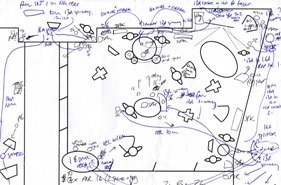 |
|
| |
|
|
|
|
|
|
|
|
|
|
|
|
|
|
|
|
|
|
|
|
|
|
|
|
|
|
|
|
|
|
|
|
|
|
|
|
|
|
|
|
| |
Sounds from beyond the
grave... |
|
|
|
|
|
|
|
|
|
|
|
|
|
|
|
|
|
|
|
|
|
|
|
|
|
|
|
|
|
|
|
|
|
|
|
|
|
|
|
|
|
|
|
|
|
|
|
|
|
|
|
|
|
|
| |
|
I held onto a
few favourite effects for this year's show - the skeleton in
the centre welcoming the visitors, the thunder and evil laughter
in the porch, and also the background music, heard at the
Boot Hill cemetery part of Phantom Manor. This
time however, this music was extended to include a section
of ghostly wailing and moaning, as well as the haunting
female singing (that of the ghostly bride character from the
attraction) that had been heard in previous experiences
(2008, 2010 and 2011).
|
|
|
|
With the new
witches scene, however, a brand new sound was required. I
remembered a section of Rumpus Mansion, where three
hags are cooking revolting recipes and cackling at visitors,
and I thought that something could be done with that sound.
So a new track was created, mixing in the hags' laughter
with rumbling and bubbling cauldron sounds, to match the
intended illusion of the witches creating a spell; smoke
would rise from their cauldron and their 'potion' would glow and change colour at the appropriate moment.
I found a great sound for another scene I had come up with,
which would feature a banshee-type figure leaning over a
chopping block while a boggart chops her head off with an
axe! I had been trying to think of something creative to do
with the new
tree stump in the garden (the remains of the eucalyptus tree
that was removed in 2012), and eventually an idea came to
me... it would make a great chopping
block for my axe-wielding characters! |
|
|
|
|
|
|
|
|
|
|
|
|
|
|
|
|
|
|
|
|
| |
|
|
|
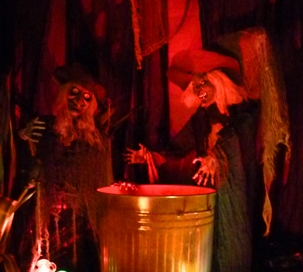 |
|
|
| |
|
|
|
|
|
|
|
|
|
|
|
|
|
|
|
|
|
|
|
|
|
|
|
|
|
|
|
|
|
|
|
|
|
|
|
|
|
|
|
|
| |
|
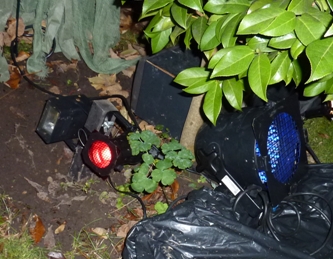 |
|
Lighting design |
|
|
|
|
|
|
|
|
|
|
|
|
|
|
|
|
|
|
|
|
|
|
|
|
|
|
|
|
|
|
|
|
|
|
| |
|
|
I chose a
similar mix of lighting as I'd used in previous
years; mainly PAR 36s and PAR 16s for spots, and then
several LED PAR 56s for larger colour washes and
colour-changing effects. I used ten PAR 16s and two PAR 36s,
mainly for lighting individual figures (including the axe
scene, the green skeleton and some of the tombstone ghouls).
A strobe was mounted up in the tree by the entrance, to
provide the initial lightning effects as visitors entered
the garden. There was also another light that produced a
ghostly 'rippling' effect over the tombstones and bushes.
The image to the left shows some of the lighting positioned
in the centre of the lawn; the red PAR 16 and strobe were
for the axe scene, while the blue LED PAR 56 was used to
light the tree at the back of the garden. |
|
|
|
|
|
|
|
|
|
|
|
|
|
|
|
|
| |
|
|
|
|
|
|
|
|
|
|
|
|
|
|
|
|
|
|
|
|
|
|
|
|
|
|
|
|
|
|
|
|
|
|
|
|
|
|
|
|
| |
Making a real ghost! |
|
|
|
|
|
|
|
|
|
|
|
|
|
|
|
|
|
|
|
|
|
|
|
|
|
|
|
|
|
|
|
|
|
|
|
|
|
|
|
|
|
|
| |
|
Ever since I
started the displays, there were effects that I had seen in
other attractions and wanted to try and build myself,
however it was impractical or too expensive to get hold of
the materials needed to make them. This was something that I
wanted to put right at the 2013 experience; there were two
effects that I was determined to do - the first was the famous Pepper's Ghost! |
|
|
|
|
|
|
|
|
|
|
|
|
|
|
|
|
|
|
|
|
|
|
|
|
|
|
|
|
|
|
|
|
|
|
|
|
|
|
|
|
|
|
|
| |
|
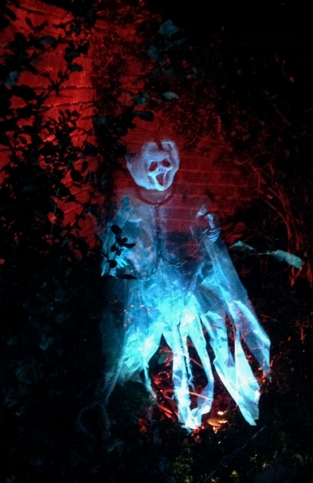
|
|
|
Pepper's Ghost
is an illusion which operates on the principle of
reflection in glass. Using
a simple setup, a translucent figure of a ghost
or similar can be made to appear and disappear in front of a
viewer's eyes.
The illusion has its origins in the 16th century, first
described in 1584 by an Italian scientist, Baptista Porta, as a way of deceiving an observer into seeing
"...in a chamber things that are not".
In 1858, the effect was developed by engineer Henry Dircks
as a way of making ghosts appear. He named his illusion Dircksian
Phantasmagoria. He used his demonstrations of this as
his way of attempting to unmask what he saw as trickery performed by those who claimed they could
contact the dead or summon spirits.
Dircks later demonstrated this effect to inventor and
scientist, Professor John Henry Pepper, who suggested how
the glass pane on which the ghosts appeared could be angled
downwards towards the audience. Dircks had already
approached various theatres with the invention, but the
requirement of raised balconies and unusual spectator
positioning had discouraged them. With Pepper's alteration,
this would no longer be needed; observers in ordinary
seats would now see the ghost!
In 1862, Pepper performed the illusion to an audience in his own lecture room, taking a scene from
Charles Dickens's The Haunted Man and enhancing it
with his new ghost. Having purchased the rights from Dircks
for five hundred pounds (about £55,000 in today's money!),
he then licensed the effect to theatres,
where it astounded and baffled big Victorian audiences. At one such
performance, even the renowned scientist Michael Faraday
admitted his perplexity, eventually requesting an
explanation as to how it was done. Pepper simply took the
scientist's hand and bumped it against the invisible pane of
glass!
Pepper enjoyed revealing the effect's workings to invited
guests, and allowing them to try it out! They could crawl into
the darkened space at the foot of the stage and see
themselves reflected as ghosts in the large glass pane above!
|
|
|
|
|
|
|
|
|
|
|
|
|
|
|
|
|
|
|
|
|
|
|
|
|
|
|
|
|
|
|
|
|
|
|
|
|
|
|
|
|
|
|
| |
|
This modified
version of the illusion was patented by Pepper in both his
and Dirck's name in 1863. Dircks, however, never understood
how Pepper's idea of the angled glass had enhanced his
invention. In fact, he thought it had limited its
effectiveness. Pepper made significant efforts to give Dircks his rightful credit as the true
originator of the effect, but his name stuck. The
illusion remains
widely used in theme parks, theatre and beyond.
The ballroom scenes at the Disney attractions The Haunted
Mansion and Phantom Manor are the largest
implementations in the world of the Pepper's Ghost illusion.
Riders look at a 27 metre-long empty ballroom through a 9 metre-tall
glass pane. Illuminated figures hidden above and below the
riders are reflected in the glass; they appear
as translucent ghosts inside the room.
|
|
|
|
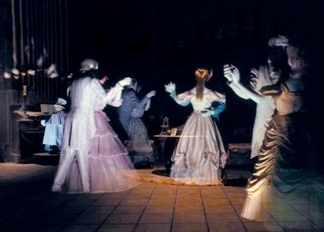 |
|
|
|
|
|
|
|
|
|
|
|
|
|
|
|
|
|
|
|
|
|
|
|
|
|
|
|
|
| |
|
|
|
Image credit: Disney |
|
|
|
|
|
|
|
|
|
|
|
|
|
|
|
|
|
|
|
|
|
|
|
|
|
|
|
|
|
|
|
|
|
|
|
|
|
|
|
|
|
|
|
|
|
|
|
|
|
|
|
|
|
|
|
|
|
|
|
|
|
|
|
|
|
|
|
|
|
|
| |
|
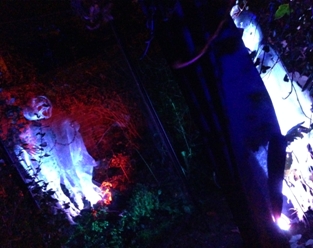 |
|
|
To create my own
version of the effect, a ghostly figure (previously used in 2010 and 2011)
was positioned in a curtained-off space behind the tree, out of
the sight of visitors. A large sheet of perspex was then positioned
opposite the figure, and angled towards the path such that visitors would see
the translucent reflection of the ghost in the perspex. A light was then
added beneath the figure, which would fade on and off during
the evening, and... there it was! My own Pepper's Ghost!
I was really pleased with how the effect turned out, with
many visitors commenting on how impressive it looked. I
spent time getting the lighting behind
the perspex to look right, as I wanted to emphasise the
transparency of the ghost; not enough light on the wall and
objects behind the
reflection would mean that this element of the effect would
be lost. I added a concealed mirrorball in this area also,
to provide a spectral, whirling light behind the ghost. |
|
|
|
|
|
|
|
|
|
|
|
|
|
|
|
|
|
|
|
|
|
|
|
|
|
|
|
|
|
|
|
|
|
|
|
|
|
|
|
|
|
|
| |
|
 |
See the workings of the Pepper's Ghost taken at
the experience, and the effect during testing in this
clip
(.mp4,
10.2mb) |
|
|
|
|
|
|
|
|
|
|
|
|
|
|
|
|
|
|
|
|
|
|
|
|
|
| |
|
|
|
|
|
|
|
|
|
|
|
|
|
|
|
|
|
|
|
|
|
|
|
|
|
|
|
|
|
|
|
|
|
|
|
|
|
|
|
|
| |
|
Continuing with
the theme of making things appear and disappear right in
front of visitors' eyes, the second classic effect that
I
decided to attempt is again widely used in both theatrical
productions and haunted-house attractions. |
|
| |
|
A scrim is a type
of material that, when lit from behind, and with no light
falling on its surface, has a transparency which allows the
observer to see through it. When
light 'grazes' across its surface, and with no light coming
from behind it, it appears opaque. Evidently, by using
careful lighting, this can be used to make ghostly figures
(or indeed any prop or person) appear suddenly in front of
an audience. For this reason it is popular in theatre and
dark rides alike, where 'shark-tooth' scrim material is
commonly used for its excellent transparency.
For the display, I decided that I would incorporate a
scrim into the porch's evil laughter and thunder sequence.
In a scene from Phantom Manor, visitors look up and
see a corpse and the ride's antagonist, 'The Phantom', in
the rafters above them. This scene is hidden using a scrim
and then revealed at the crucial moment via a lighting
change.
It was fun to create a little
tribute to this scene by hanging a full-size rubber skeleton
behind the scrim, which was then suddenly revealed to
visitors, standing less than a metre away, in amongst the
lightning flashes and thunder when they reached the porch! A
brilliant effect! |
|
|
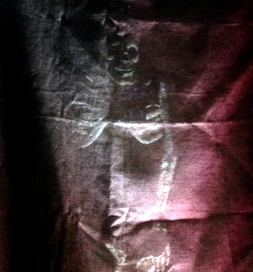 |
|
| |
|
|
|
|
|
|
|
|
|
|
|
|
|
|
|
|
|
|
|
|
|
|
|
|
|
|
|
|
|
|
|
|
|
|
|
|
|
|
|
|
| |
|
Bringing the witches to
life |
|
|
|
|
|
|
|
|
|
|
|
|
|
|
|
|
|
|
|
|
|
|
|
|
|
|
|
|
|
|
|
|
|
|
|
|
|
|
|
|
|
|
|
|
|
|
| |
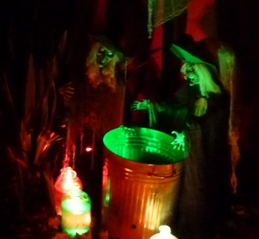 |
|
|
Building the
witches scene was a fun process.
It was a development of a scene from the 2011 experience,
which contained a similar 'cauldron' (alright, a metal bin!) and a single witch.
Having created an appropriate soundtrack, the problem arose
that the audio contained two witches cackling, while I only
had one witch figure. So that is the main reason
why I decided to make a larger scene;
I needed another witch in order to use the sound! |
|
|
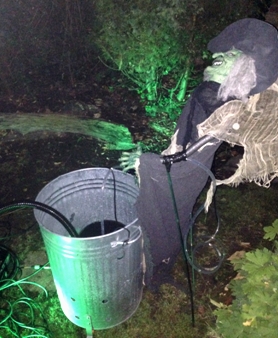 |
|
|
|
|
|
|
|
|
|
|
|
|
|
|
|
|
|
|
|
|
|
|
|
|
|
|
|
|
|
|
| |
Having obtained
a second witch figure, I then came up with the idea of
adding a water pump such that one of the witches could
actually be making spells - pouring 'potions' into the
cauldron (my obsession with fountains and ponds has never
gone away!). This effect worked really well, although only the
most observant of visitors may have seen the water
falling from the witch's bottle - a subtle effect, happening
only for a few seconds, but an effective one nonetheless.
The image to the right shows the witch with the bottle being
tested along with the water pump. There are two pipes
visible; the clear one is for the water (pumped from
the black container that is also partly visible). The black
pipe was used for bringing smoke into the cauldron from a
machine hidden around the back of the scene. |
|
|
|
|
|
|
|
|
|
|
|
|
|
|
|
|
|
|
|
|
|
|
| |
|
 |
Watch a test of the witch effects in this
short clip
(.mp4, 4.8mb) |
|
|
|
|
|
|
|
|
|
|
|
|
|
|
|
|
|
|
|
|
|
|
|
| |
|
|
|
|
|
|
|
|
|
|
|
|
|
|
|
|
|
|
|
|
|
|
|
|
|
|
|
|
|
|
|
|
|
|
|
|
|
|
|
|
| |
New animated figures |
|
|
|
|
|
|
|
|
|
|
|
|
|
|
|
|
|
|
|
|
|
|
|
|
|
|
|
|
|
|
|
|
|
|
|
|
|
|
|
|
|
|
|
|
|
|
|
|
|
|
|
|
|
|
|
|
|
|
|
|
| |
In the earlier years
of designing these displays, I
never had access to professional motor equipment or anything
near the standard of theme park attraction animation, so I had
increasingly shied away from including 'home-made' motorised
props, as they often could not operate reliably enough! However, for 2013, I
came across a method which I believed could work well. |
|
|
|
|
|
|
|
|
|
|
|
|
|
|
|
|
|
|
|
|
|
|
|
|
|
|
|
|
|
|
|
|
|
|
|
|
|
|
|
|
|
|
| |
|
Having come up
with the idea of using the new tree stump in the garden as
the home of the 'axe scene', I set about considering ways in
which this could be animated. At the same time, I had come
across two figures that would be perfect for the setup; both
were headless ghouls that would match the theme of the scene
really well.
In my search for suitable motors, I came across an old DMX
light that had fallen into disrepair. This had two stepper motors
that were used to move a mirror left and right, and up and
down, in order to reflect a beam of light in different
directions. I figured that if I could extend the motors'
cables so that they could be mounted outside of the device,
I could use DMX to move them, and then program them in the
same way as the lights and sound. |
|
|
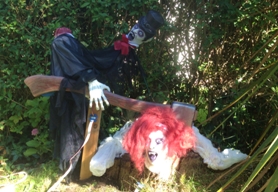 |
|
|
|
|
|
|
|
|
|
|
|
|
|
|
|
|
|
|
|
|
|
| |
|
Having
successfully made a mount for the axe and the banshee's
head, and counter-balanced both of them, it was time for a
test. The photo above shows the original appearance of the
axe scene, taking during a sunny testing session in
September 2013. Here, the figure holding the axe is
different to the one eventually used; I
decided to change this as it looked odd having an already
headless 'executioner'! The new figure also had a larger
black 'cloak' and bigger hands, which made it easier to hide
the motors and cables. |
|
|
|
|
|
|
|
|
|
|
|
|
|
|
|
|
|
|
|
|
|
|
|
|
|
|
|
|
|
|
|
|
|
|
|
|
|
|
|
|
|
|
|
|
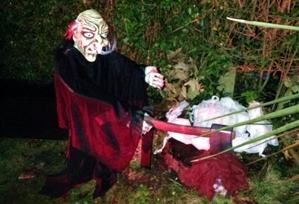 |
|
|
|
|
|
|
|
|
|
|
|
|
|
|
|
|
|
|
|
|
|
|
|
|
|
|
|
|
|
|
|
|
| |
|
|
 |
See
the effect during its initial testing stages in
this clip.
The axe and head motors were yet to be synchronised.
(.mp4, 7.3mb) |
|
|
|
|
|
|
| |
|
|
|
|
|
|
|
|
|
|
|
|
|
|
|
|
|
|
|
|
|
|
|
|
|
|
|
|
|
|
|
|
|
| |
|
|
|
While it
certainly wasn't up to Disney standards, I was made up with
how it turned out! It was in some ways new territory for the
Halloween Experience; the first pre-programmed,
auto-resetting audio-animatronic! While the motors did
squeal a bit after a while (although I think that was more to do
with their age!), the effect held out and it was one of my
favourite features of this year's show, while several
visitors said how much they liked it too! |
|
|
|
|
|
|
|
|
|
|
|
|
|
|
|
|
|
|
|
|
|
|
|
|
|
|
|
|
|
|
|
|
|
|
|
|
|
|
|
|
|
|
|
|
|
|
|
|
|
|
|
|
|
|
|
|
|
|
|
|
|
|
|
|
|
|
|
|
|
|
|
|
|
|
|
|
|
| |
|
Visit the 2013 experience
again... |
|
|
|
|
|
|
|
|
|
|
|
|
|
|
|
|
|
|
|
|
|
|
|
|
|
|
|
|
|
|
|
|
|
|
|
|
|
|
|
|
|
|
|
|
|
|
|
|
| |
|
 |
Take a tour
through the Halloween Experience 2013
with this walkthrough clip
(.mp4, 21.3mb) |
|
|
|
|
|
|
|
|
|
|
|
|
|
|
|
|
|
|
|
|
|
|
|
|
|
|
|
|
|
|
|
|
|
|
|
|
|
|
|
|
|
|
|
|
|
|
|
|
|
|
|
|
|
|
|
|
|
|
|
|
|
|
|
|
| |
|
October 31st
2013 - nine years since all this Halloween mayhem opened for the first
time. So that meant that the following year would be the ten
year anniversary! Something special would certainly be
needed for that!
Read on to see how everything took an un-dead twist for
2014! |
|
|
|
|
|
|
|
|
|
|
|
|
|
|
|
|
|
|
|
|
|
|
|
|
|
|
|
|
|
|
|
|
|
|
|
|
|
|
|
|
|
|
|
| |
 |
|
|
|
|
|
|
|
|
|
|
|
|
|
|
|
|
|
|
|
|
|
|
|
|
|
|
|
|
|
 |
|
|
|
|
|
|
|
|
|
|
|
|
|
|
|
|
|
|
|
|
|
|
|
|
|
|
|
|
|
|
|
|
|
|
|
|
|
|
|
|
|
|
|
|
|
|
|

